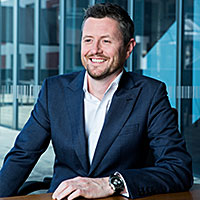The Provost & Chief Academic Officer, Allan Evans, has an ongoing Curriculum Innovation Process – looking at what we’re doing well, where we could do better and how best to ensure we capitalise on the opportunities afforded to us by new technologies and learning analytics as we seek to deliver relevant, student-centred education. The first phase of that process has concluded, and all our Schools have had feedback and direction. In parallel, our DVC-Research & Innovation, Richard Head, has reviewed research activity and concentrations across the university, through the lens of a changing national landscape for research investment and our transformational objectives from Crossing the Horizon. Both of these processes have highlighted the need for us to invest in our areas of strength, to enhance our differentiation and to accelerate our competitiveness. In the case of Allan’s curriculum review, it is clear that we have too many program offerings, and an overly complex presentation of choices to incoming students. Schools are being asked to take this on board, to re-organise their offerings and to embed a future of blended learning – affording greater flexibility to our students in their learning.
In the case of research, Richard has outlined his framework for research activity, including a need for action, now, to ensure critical mass, scale and impact are achieved from our research institutes and to provide greater connection between our research and education agendas. Richard’s interdisciplinary research themes have been identified and we’ll shortly begin work to align our institutional investment in research for future years to meeting our objectives around concentration, quality and thematic connection.
In the same timeframe, our DVC-International & Engagement, Nigel Relph, has also produced and launched our Global Engagement Framework, which clearly set out our targets and goals in international education and which has had great input from our Schools. That framework also sets out our intent around offshore campus collaborations and our venture into Singapore, with enrolments targeted for September 2014, flows directly from this work.
In all of these cases the analyses highlighted areas where specific changes would be needed to better position us for future success. For example, on the academic front, looking though the ‘One Team’ lens during Allan’s review made it clear that maintaining a ‘separate’ regional education structure is simply not conducive to our objective of increasing our offerings in the regions – hence the CRE structure is now being re-integrated to Schools and Support Units – in essence, ensuring that regional engagement is a whole of institution undertaking. Also at a structural level, a new senior position, the Pro-Vice Chancellor: Student Engagement & Equity has been created and soon will join the Senior Management Group to ensure this core portfolio is linked across the university.
On the international front, Nigel’s Framework necessitated a review of our international supports, with that structure soon to be rolled out to provide a much needed institutional core for the coordination of our transnational education activities.
Richard’s research analysis is also bringing about some structural change – with increased responsibility for new business generation being taken on by ITEK, the integration of research analytics activities to the Business Intelligence and Planning unit and a refocusing of activities in the area of graduate studies through significant revision of the future role of the Dean of Graduate Studies, shifting the emphasis from compliance to enabling the transformation of the PhD in UniSA. That revamped position will be advertised soon.

Through The Big Picture, I hope that our whole community gains a greater and current appreciation of what is going on, how it fits together and how our activities connect and reinforce each other at a whole of enterprise level.
Archive
Tag cloud
- Across boundaries
- Alumni Awards
- Anniversary
- Antep
- Appointment
- Big challenges
- Big Ticket Items
- Birthday
- Budget
- Centre for Business Growth
- Chancellor
- Change
- Charles Bolden
- Communication
- Community
- Community International Borders
- Coordination
- Crossing the horizon
- Deadly Alumni
- Defence
- Dr Jane Goodall
- Education reform
- Engagement
- Enterprise
- Enterprise agreements
- Enterprise bargaining
- Enterprise Support Plans
- Enterprise25
- entrepreneurship
- Equity
- ERA
- Flexible learning
- Framework
- Funding
- Future Industries Institute
- Future University
- Global
- graduations
- Graduations
- Great Hall
- Integration
- Introduction
- ITEK
- Jeffrey Smart building
- Kemp Norton review
- Merger
- NASA
- Negotiation
- One team
- open day
- People
- Politics
- Practical Challenges
- Precincts
- Pridham Hall
- Programs
- Rankings
- Reconciliation
- Reconciliation plan
- Research
- SciCEd
- Sir Terry Pratchett
- Spirit of Enterprise
- Staff awards
- Strategic Partnerships
- Strategic Plan
- Tour Down Under
- Transformation
- Travel
- Unijam
- Vice chancellor
- Volunteer
- Watt Review
- Well being
- World Class



